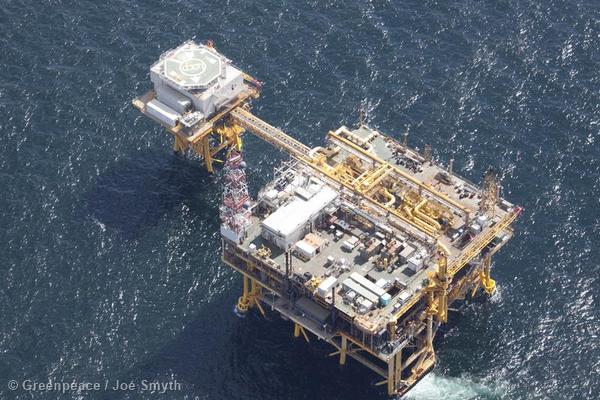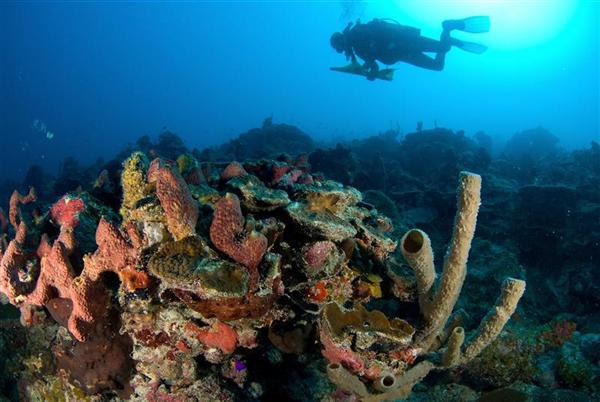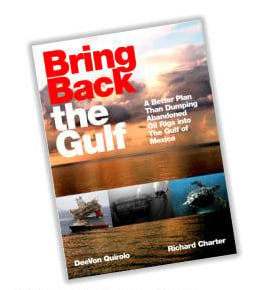Guest post by Senior Fellow at The Ocean Foundation Richard Charter
You may have never thought about an oil rig sitting on the ocean floor, but there are more than 400 of them discarded as artificial underwater habitats in the Gulf of Mexico.
Right now, this summer, the Interior Department is revisiting their policies governing the disposal of old drilling rigs and other petroleum infrastructure throughout the federal waters of our Gulf of Mexico. When an oil company signs an offshore lease contract, that includes an obligation to return the seabed to is natural state once the rig has reached the end of its economic life. Americans have every right to expect that each company will keep its promise. With thousands of rigs due for decommissioning in the next few years, we can either decide to help restore the Gulf of Mexico to its former vitality, or allow it to become a junkyard of epic proportions.
“Bring Back the Gulf” is a new book released today by The Ocean Foundation and The Herbert W. Hoover Foundation to expose the dangerous misconceptions being promoted by Big Oil as it tries to fool the American public about the merit of dumping abandoned oil rigs into the Gulf of Mexico, and soon, off of the California coast. Many in the scientific and conservation community recently sent a letter encouraging responsible decommissioning to Interior Secretary Sally Jewell, who is currently reconsidering how best to deal with the upcoming tidal wave of abandoned rigs in the Gulf of Mexico.
At this point in time there are more than 5,000 active leases in the Gulf of Mexico with over 2,600 rigs destined for decommissioning, and while not every one of those could find itself in line for seafloor disposal, companies will no doubt pursue that cheaper option for many of them. The Gulf of Mexico and the Mississippi River Delta, like the few other similar lush river deltas around the planet, were at one time among the most productive ecosystems on earth, but now have become a vast industrial and chemical experiment, and the results of that experiment are not looking encouraging.
The good news is that whenever an oil company has leased a federal offshore tract in the Gulf, it has at the same time also signed a contract promising that it will remove that drilling rig at the end of its useful life, reuse or recycle the components, seal off all remaining wellheads, and then restore the seafloor to as-near natural conditions as possible. The Interior Department calls this their Idle Iron policy. No Idle Iron is to be left in place as a public liability, to present a hazard to navigation, or to put Gulf waters at risk of pollution or other harm in the event of hurricane damage. The oil and gas industry would like to have us all believe that leaving a spent oil platform in place, or cutting it off and dumping it on the seafloor nearby, magically creates something resembling a coral reef, when in fact the simple biofouling community on the leftover seafloor junk does not resemble a natural coral reef. A clever and persistent oil industry public relations campaign has, for too long, dominated the discussion of how best to responsibly dispose of Idle Iron.
The Interior Department continues to be under great political pressure to allow more and more waivers exempting companies from their Idle Iron removal policies, because oil interests can generally expect to save at least half of their end-of-life decommissioning costs by just using seabed disposal. Now, more than ever, while Interior is engaged in revisiting their Idle Iron policy and considering stronger decommissioning regulations, even as the disposal of so many rigs is coming up in the next decade of so, it is important for the public to have a true picture of whats in the balance, so now were introducing a new book about whats really going on.
Recently, the Obama Administration announced new seismic airgun surveys that will lead to opening the Atlantic Coast from Maryland down to Cape Canaveral in Florida to offshore drilling. We need to know if rigs there will eventually just be dumped on the seafloor as well. As of July 31, 2014, the Interior Department is just concluding a comment period on their preparation of a new Five-Year Offshore Drilling Plan from 2017 through 2022 thats expected to target the California coast, the Atlantic coast, Floridas Gulf Coast and Panhandle, and even more of the Arctic Ocean.
Where will spent rigs be dumped someday in these regions?
Today, at this critical moment, we are releasing Bring Back the Gulf, a clear and concise explanation of the fundamental steps that must be taken now to improve the chance that we may someday bring back the Gulf of Mexico. We need to stop the routine issuance of waivers to the Idle Iron policy at the Department of Interior, we need to carefully re-examine what has been misleadingly called the Rigs-to-Reefs program, and we need to involve the public in the federal and state decision-making process that has been enabling the oil industry to increasingly avoid their corporate responsibility to bring back the Gulf.
Read more and download Bring Back the Gulffor both Kindle & iPad.






